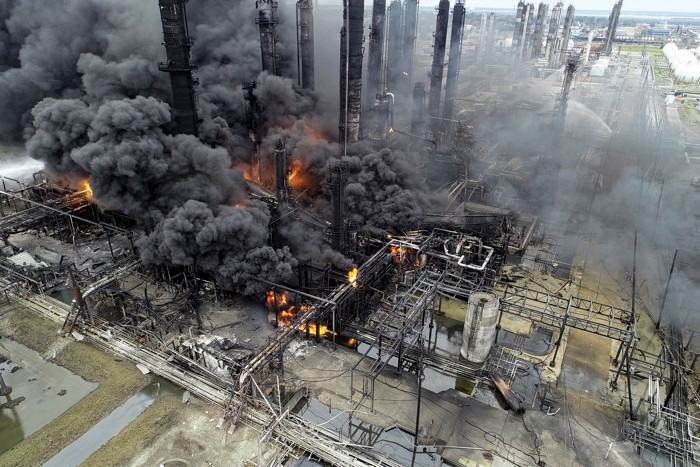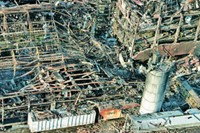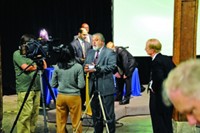Advertisement
Grab your lab coat. Let's get started
Welcome!
Welcome!
Create an account below to get 6 C&EN articles per month, receive newsletters and more - all free.
It seems this is your first time logging in online. Please enter the following information to continue.
As an ACS member you automatically get access to this site. All we need is few more details to create your reading experience.
Not you? Sign in with a different account.
Not you? Sign in with a different account.
ERROR 1
ERROR 1
ERROR 2
ERROR 2
ERROR 2
ERROR 2
ERROR 2
Password and Confirm password must match.
If you have an ACS member number, please enter it here so we can link this account to your membership. (optional)
ERROR 2
ACS values your privacy. By submitting your information, you are gaining access to C&EN and subscribing to our weekly newsletter. We use the information you provide to make your reading experience better, and we will never sell your data to third party members.
Industrial Safety
Chemical Safety Board plots new course
After completing 17 backlogged investigations, the US accident investigation agency is looking to start fresh
by Jeff Johnson, special to C&EN
January 23, 2024

At the end of 2023, the US Chemical Safety and Hazard Investigation Board (CSB) eliminated a backlog of 17 unfinished accident reports, an obstacle that had plagued the organization for years. One of the incidents occurred 7 years ago.
The CSB by the numbers
▸ 43: Full-time staff
▸ $14.4 million: 2023 budget
Over 25 years:
▸ 129 incident investigations
▸ 900 safety recommendations
▸ ~100 safety videos.
The CSB’s chair, Steve Owens, is now seeking to avoid the problems that created the backlog. He says he hopes to reshape the agency to better fulfill its mission of determining the root causes of chemical accidents and recommending changes to keep them from happening again.
The CSB is a unique government agency that Congress created in 1990 after US industrial regulators—the US Environmental Protection Agency (EPA) and the Occupational Safety and Health Administration—failed to issue timely accident reports. Eight years slipped by before the CSB was funded—and only then because of pressure from an influential New Jersey senator when a chemical plant blew up near his home and an investigation was not completed.
The CSB investigates a wide range of chemical-related accidents, but its primary focus is on large industrial incidents. It issues detailed safety recommendations to companies, regulators, workers, and communities.
Over the years, it has investigated and issued reports on some 120 incidents and prepared and distributed about 100 safety videos, which are popular with unions, companies, and safety advocates worldwide. The board has no enforcement authority. Its reports and root cause investigations are its only power.
But delays in issuing reports generated criticism from members of Congress, community groups, and industry and raised questions about the value of this small agency with the big job of investigating significant, chemical-related incidents. A turning point came in July 2022. Previous chair Katherine Lemos had just resigned from the CSB board, and Owens and Sylvia Johnson had recently joined. Owens was later elevated to chair.
At that time, Owens called the backlog “unacceptable,” and he and Johnson said they were determined to conclude the unfinished investigations and issue reports by the end of 2023. A year ago, Catherine Sandoval joined the board, bringing its membership to three, still two short of its designated five.
Even worse, the total number of CSB staff members had shrunk to 29 from a high of 44. And the number of accident investigators on staff was down from 24 to 9.
The 17 incidents involved a host of chemicals—including natural gas, liquid nitrogen, combustible dust, and hydrochloric acid—and chemical processes of many types. Owens says that completing the reports, particularly the oldest, “often required new investigations and took an extraordinary effort by every single employee at the CSB, working together as a team. We are committed to ensuring that such a serious backlog never happens again.”
But getting the funding to keep that promise is far from guaranteed. The CSB’s independence has drawn ire over the years from some US presidents and members of Congress. Until 2023, the CSB’s budget had never topped $12 million, far short of what many safety experts say is needed to investigate some of the world’s most complicated and violent industrial accidents.
Donald J. Trump brought matters to a head when, as president, he tried three times to eliminate the CSB. Although Congress thwarted Trump, staff morale tanked, and many employees fled, according to former staffers. “Who would want to work at a doomed agency?” one of them told C&EN at the time.
But today the CSB has only two investigations remaining, both launched after the July 2022 management change. It now has a staff of 43, including 17 full-time investigators and 3 recently hired interns with graduate degrees in chemical engineering.
Owens credits the investigators with the lion’s share of the catch-up work but says rebuilding the agency was a full-court press, requiring financial, human, and management resources. “Actually, completing the unfinished reports may have been a good introduction for newer employees,” he says. “In some cases, the files were old, and no one was around who had originally done the investigations, so new investigators had to reconstruct much of the details.”
On the flip side, the CSB nearly froze new investigations over the past year and a half, even as incidents continued. During this period, 154 accidents have occurred in the US that meet the CSB’s criteria for an investigation: a fatality, serious injury, or property damage exceeding $1 million. These incidents resulted in the deaths of 19 people, and the CSB investigated only 2 of them.
Owens won’t predict how many incidents the CSB will investigate in the future. To speed the process, he says, the agency will rely on teams of four to five investigators per incident and supplement with contractors who have expertise in analyzing areas such as blasts, explosives, and strength of materials. Previously, he says, the CSB too often relied on a single investigator per incident, which slowed the process.
“We will have to be careful that we can support the number of investigations we conduct at the same time. We don’t want another backlog,” Owens says. “But if something happens that we feel we must investigate, we will.”
Owens says that since he started at the CSB, he has been thinking about the families of people badly injured or killed and about people who had their homes destroyed. “These incidents cause a massive amount of destruction in a person’s life, and they want to know what went wrong and how this sort of thing can be avoided so it never happens again,” he says. “They don’t want to wait 3, 4, 5 years for an answer. We want to do good investigations and reports, but they must be timely so our work matters.”
Owens’s ballpark estimate is that issuing future reports will take 18 months and be supplemented with periodic updates. He acknowledges that timely reports have been the goal of all previous CSB boards, and most have failed.
But Owens, a former EPA assistant administrator and state safety official, thinks this time will be different. First, because the agency has eliminated the report backlog, staffers can focus on current investigations. Second, Owens notes, the CSB’s budget request for 2024 is $17.4 million, a 20% increase over 2023 funding.
Congress turned down past requests for budget hikes of this magnitude, but the agency’s success in clearing the investigation backlog might sway lawmakers to support it, says Steve Sallman, health, safety, and environment director of the United Steelworkers, which represents workers at several chemical plants.
“The current CSB leadership and career staff have been doing incredible work to dig out of the mess they were left with, and our union applauds their efforts,” Sallman says. “The CSB is a small agency with a huge responsibility. Congress needs to fund it accordingly, with an emphasis on increasing their staffing levels.”
Similarly, the American Chemistry Council, a trade association, and the Coalition to Prevent Chemical Disasters, which includes community members and environmental health and justice organizations, applaud the work of the CSB to eliminate the backlog. The groups urge lawmakers to provide resources to ensure the board can fulfill its mission.
As the CSB launches new investigations, Owens says, it will closely watch two areas of major concern: the impact of extreme weather events, such as high winds and hurricanes, and the use of hydrofluoric acid (HF).
He says the agency will continue urging regulators to prioritize inspections of refinery fluid catalytic cracking units that use HF, a highly toxic acid, as an alkylation catalyst. Such units have been the subject of several CSB investigations and recommendations.
The CSB also has begun examining data generated by its 3-year-old incident reporting rule. The rule requires companies to report and describe significant accidents that occur at their facilities. Roughly 150 of these incidents are reported annually. The CSB’s three chemical engineering interns have begun studying details revealed through the incident reporting rule. The work could result in an incident trend report or safety products, alerts, and videos, Owens says.
One problem the CSB discovered as it cleared up old accident reports, Owens notes, is that companies often knew about conditions that led to accidents but ignored them. For instance, he says, its investigations revealed that accidents occurred even when employees had raised concerns over safety conditions or companies conducted risk analyses that revealed flaws. These companies could have avoided the incidents if they had taken corrective actions.
Owens says that reaching his goals will require streamlining the CSB and empowering investigators and other staffers. “We have a lot of new people,” he says. “Some investigators have just gone out on their first incident investigation. This is all new to them. This is a work in process for us now.
“We have to reshape the structure of our bureaucracy and let people do their jobs,” he says. “We have to demonstrate to staff we are all in this together and all are pulling on the same oar.”





Join the conversation
Contact the reporter
Submit a Letter to the Editor for publication
Engage with us on Twitter